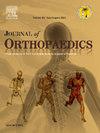Sociodemographic characteristics and outcomes of surgically managed central cord syndrome patients
IF 1.5
Q3 ORTHOPEDICS
引用次数: 0
Abstract
Introduction
Undiagnosed cervical spine stenosis is a risk factor for central cord syndrome (CCS), especially in vulnerable individuals. Social determinants of health (SDOH) are correlated with health outcomes. The aim of this study was to characterize the sociodemographic characteristics and outcomes in surgically-treated central cord syndrome (CCS) patients, and explore potential associations between them.
Methods
This is a retrospective cohort study of surgically-treated CCS patients at a Level-1 trauma center between 2015 and 2021. Patient demographics, radiological findings, and clinical outcomes were collected. SDOH were estimated using the Social Deprivation Index (SDI) and Area Deprivation Index (ADI). Descriptive statistics and regression analyses assessed associations between SDI/ADI, demographics and clinical outcomes.
Results
Of 56 patients, 75 % were insured by Medicare/Medicaid and 70 % were discharged to care facilities. Mean SDI was 66.4 ± 24.4, and mean ADI was 7.4 ± 2.2. Three patients required reoperation for post-operative complications. Post-operative neurologic outcomes varied, with 60.7 % stable, 30.4 % improved, and 8.9 % declined. While SDI/ADI did not correlate with outcomes, higher ADI quartiles were associated with decreased likelihood of home discharge (p = 0.048). Decline in neurologic function was associated with Medicare/Medicaid or Military insurance (p = 0.011).
Conclusions
The results of this study indicated that CCS patients typically come from lower socioeconomic backgrounds, as indicated by high SDI and ADI scores. Despite this, we did not find significant correlations between SDI or ADI with post-operative outcomes, and most patients had stable or improved neurological function post-surgery in our cohort. Future studies with larger sample sizes will provide a more comprehensive understanding of these findings.
经手术治疗的中央脊髓综合征患者的社会人口学特征和疗效
导言未确诊的颈椎管狭窄是中枢神经脊髓综合征(CCS)的一个风险因素,尤其是对脆弱人群而言。健康的社会决定因素(SDOH)与健康结果相关。本研究旨在描述经手术治疗的中枢神经脊髓综合征(CCS)患者的社会人口学特征和预后,并探讨两者之间的潜在关联。研究收集了患者的人口统计学资料、放射学检查结果和临床结果。采用社会贫困指数(SDI)和地区贫困指数(ADI)估算SDOH。描述性统计和回归分析评估了 SDI/ADI、人口统计学和临床结果之间的关联。平均 SDI 为 66.4 ± 24.4,平均 ADI 为 7.4 ± 2.2。三名患者因术后并发症需要再次手术。术后神经功能结果各不相同,60.7%稳定,30.4%好转,8.9%下降。虽然SDI/ADI与疗效无关,但ADI四分位数越高,出院回家的可能性越小(p = 0.048)。神经功能下降与医疗保险/医疗补助或军队保险有关(p = 0.011)。结论本研究结果表明,CCS 患者通常来自较低的社会经济背景,这一点从较高的 SDI 和 ADI 分数可以看出。尽管如此,我们并没有发现 SDI 或 ADI 与术后结果有明显的相关性,在我们的队列中,大多数患者术后神经功能稳定或有所改善。未来样本量更大的研究将使我们对这些发现有更全面的了解。
本文章由计算机程序翻译,如有差异,请以英文原文为准。
求助全文
约1分钟内获得全文
求助全文
来源期刊

Journal of orthopaedics
ORTHOPEDICS-
CiteScore
3.50
自引率
6.70%
发文量
202
审稿时长
56 days
期刊介绍:
Journal of Orthopaedics aims to be a leading journal in orthopaedics and contribute towards the improvement of quality of orthopedic health care. The journal publishes original research work and review articles related to different aspects of orthopaedics including Arthroplasty, Arthroscopy, Sports Medicine, Trauma, Spine and Spinal deformities, Pediatric orthopaedics, limb reconstruction procedures, hand surgery, and orthopaedic oncology. It also publishes articles on continuing education, health-related information, case reports and letters to the editor. It is requested to note that the journal has an international readership and all submissions should be aimed at specifying something about the setting in which the work was conducted. Authors must also provide any specific reasons for the research and also provide an elaborate description of the results.
 求助内容:
求助内容: 应助结果提醒方式:
应助结果提醒方式:


